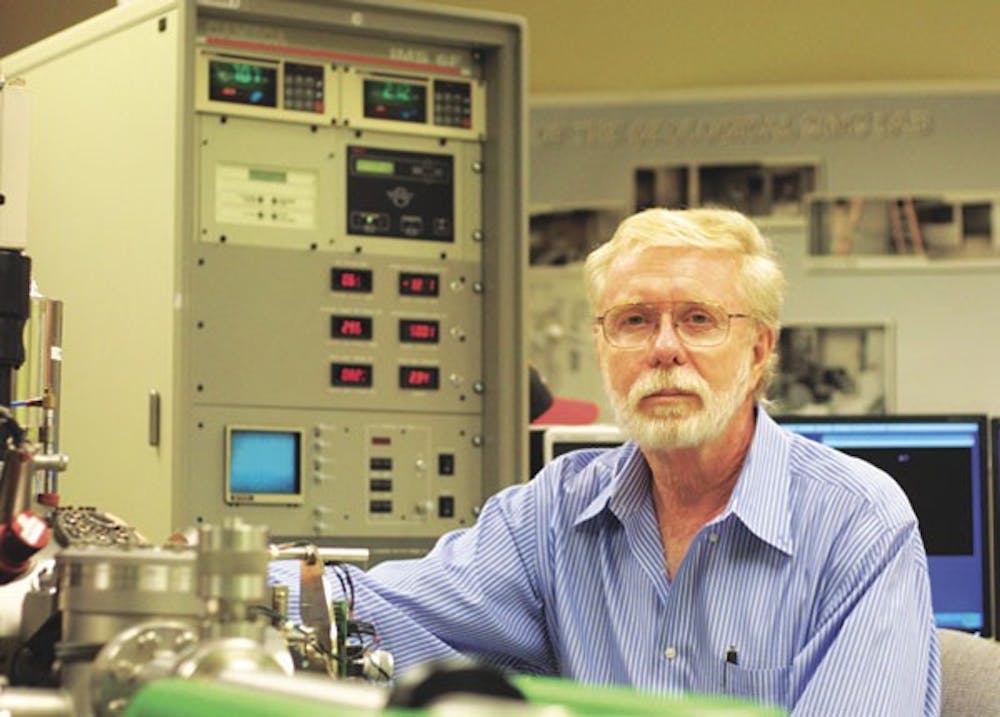There are only seven NanoSIMS 50 instruments in the United States, and ASU received a grant from the National Science Foundation to purchase the instrument because 13 researchers need its capabilities to advance their research.
Peter Williams, the principal investigator for the grant and a chemistry and biochemistry professor, has been working with SIMS technology for around 40 years.
The spectrometer uses a beam of ionized atoms to focus on a spot around 50 nanometers in size, which is less than a thousandth of a human hair in diameter, he said.
The ions strike the surface and blast off and ionize atoms, which are then separated and analyzed, he said.
Williams added in an e-mail that the process of scanning the beam over the surface creates a high-resolution image of the sample.
The spectrometer has seven detectors, allowing researchers to look at up to seven of these elements or isotopes at the same time.
He said there are two similar instruments in the SIMS lab at ASU that were brought to ASU in 1984 and 1999, but this new technology is more advanced.
“This is basically the latest and greatest instrumental design,” Williams said.
Right now, the spectrometer is stuck in a warehouse until the lab area is renovated and space is cleared.
The two-and-a-half-ton instrument and other computer equipment will take up about a 12-by-21 foot area, he said.
“It’s big enough so it just barely gets through the corridors if we take out a couple of doors,” Williams said. “The performance improves if you make it bigger.”
Researchers, including undergraduate and graduate students, will be able to use the spectrometer.
“At a university, we don’t lock these things away,” Williams said. “The more the merrier. People will come basically with projects to do on this instrument.”
The facility has attracted researchers from all over the United States and other countries, including Russia and Switzerland.
Other universities usually don’t have more than two of these types of instruments, he said.
Richard Hervig, a geochemistry professor, has worked with Williams since 1985 on SIMS technology.
Hervig will conduct research on chemical changes inside a volcano, though he said he hasn’t drawn limitations for other research possibilities.
“Anything that we’d like to understand the chemistry of on a small scale, whether it’s a mineral from this planet or from others, the NanoSIMS opens up the door to do that kind of work,” he said.
Lynda Williams, a geochemistry research professor and manager of the SIMS lab, will use the spectrometer to look more in-depth at antibacterial clay minerals.
“People have used clays since the beginning of recorded history to heal various wounds [and illnesses],” Williams said.
She became interested in antibacterial clay when she found out about clay from France that cured flesh-eating bacteria.
“I want to look at the transfer of different elements from the natural rock or mineral and into the bacteria,” Williams said.
Current technology only allows her to identify what elements are in the bacteria but not where they’re located inside, which would help her understand the healing process and how the bacteria are killed.
“These particular clays we found are killing antibiotic-resistant strains of bacteria, so that’s why we want to understand how they work,” she said.
It can take many hours and weeks to get results, depending on the project, and a person is hired to run the spectrometer, she said.
“It’s not something like you come in and stick your sample in and push the button and you get a result in a few hours,” Williams said.
Reach the reporter at reweaver@asu.edu





